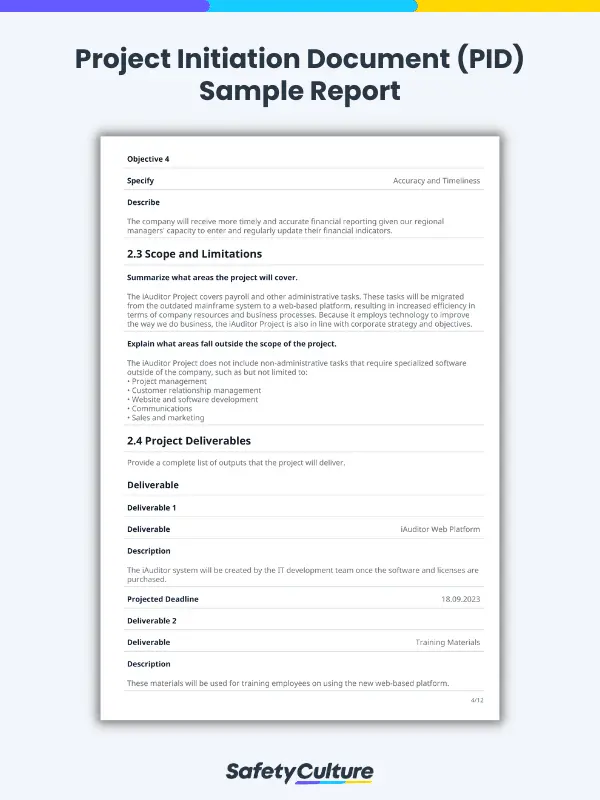What is a Project Initiation Document (PID)?
A Project Initiation Document (PID) lays out foundational information about the project, such as its context, purpose, scope, management, and success metrics. It provides project teams with an initial overview of how things will work before carrying out the project. With a PID, project teams can confidently take the first step in the right direction toward successful project implementation.
Why is it Important?
A project initiation document is essential for two purposes: guidance and buy-in. First, it maps out all the necessary details to help teams kickstart the project before the project planning stage. By setting the tone and context of the project, team members will know what to expect once the project commences. It also serves as a basis for critical decisions at the early stages of the project.
Aside from this, a PID is crucial for securing stakeholder buy-in for the project. Creating a solid PID, alongside a compelling business case, can build your stakeholder’s trust and confidence in carrying out the project, which is key in convincing them to get on board with your project.
What to Include in a Project Initiation Document Template
Project managers can benefit from using a project initiation document template to simplify the writing process. Managers simply need to fill in the information in this template and submit their proposals with ease.
Generally, a PID template consists of the following parts:
- Summary – Briefly discuss project details such as its title, code, budget, and timeline.
- Definition – Introduce the project to the readers by explaining its background, purpose, scope, and deliverables.
- Cost-benefit analysis – Describe how the project can add value and drive business growth and what setbacks the project teams might encounter while implementing it.
- Roles and responsibilities – Designate persons and teams responsible for specific tasks in the project. Establish a clear structural hierarchy with an organizational chart.
- Project strategy – Map the specific steps that the team will take to reach the project goals and targets. This can also include performance metrics, monitoring mechanisms, and communication strategies.
- Approval – Provide a space for the project owner or manager to approve the document.
How to Make a Project Initiation Document
After learning the items to include in a PID template, this section will walk you through the steps in creating your own project initiation document:
1. Give Context to the Project.
When writing a PID, the first thing to establish is the project’s background. What exactly are the business drivers that necessitate this project? It can be an opportunity for business growth or a problem that needs to be solved.
2. Establish the Project Framework.
Once you’ve contextualized the project, proceed with discussing its general framework. This section keeps your team aligned with the approach of the project in line with its goals. Some details to consider while writing this section include the following:
- Objectives – Describe specific outcomes that the project aims to achieve.
- Scope and limitations – Briefly summarize what areas fall under and outside the scope of the project.
- Key deliverables – List the specific outputs that the project aims to deliver.
3. Present Your Business Case.
After polishing the basic project details, it’s time to justify your project’s use case to the board and stakeholders. Explain how your project will benefit the company and balance it with the potential constraints you might face before or during its implementation.
This section is crucial for getting everyone on board with the project, so make sure to dedicate enough time to present your case. A business case template proves to be a helpful tool for this endeavor.
4. Assign Roles and Responsibilities.
Upon completing your business case, you can now designate who’s responsible for specific tasks in the project. In this section, specify the role, the person assigned, and a short description of their responsibilities. Doing so lets team members know what their job is and what they are accountable for.
It also helps to have an organizational chart that clearly illustrates the project hierarchy. This chart informs everyone of whom to report to, especially in case of troubleshooting issues.
5. Define Specific Steps and Control Mechanisms.
Lastly, a project initiation document should include your initial project strategy. In this section, you can map out a tentative project timeline and specify mechanisms for project control.
Start by having a rough sketch of the project milestones, deadlines, and specific deliverables. Follow this by outlining benchmarks for success and mechanisms to monitor the progress of the project, including communication channels with stakeholders. You can also attach your initial project plan or project plan template in this section for further details.
To illustrate this case, here’s an example of a project initiation document template when completed in a digital format:
FAQs about PID Templates
When initiating a project, managers must prepare the following documents:
- Business case
- Cost estimate
- Customer requirements
- Feasibility report
- Impact analysis
- Mission statement
- Organizational chart
- Project charter
- Risk analysis
- Statement of work
Project initiation generally falls under the responsibility of the project sponsor and project manager. These two people work together to define the context, scope, goals, and other pertinent details of the project and complete the required documentation.
Typically, a business case is written first, serving as a documented justification to proceed with a specific project. This document is then included in the final project initiation document, which will be submitted to the project body for review and approval.




